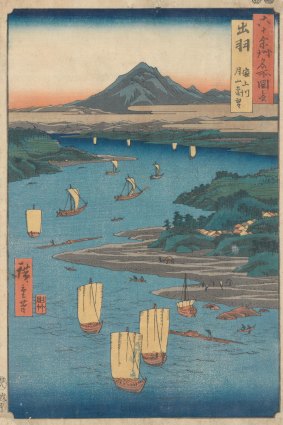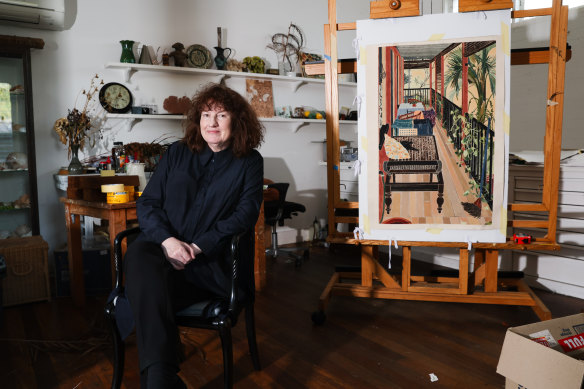
What both Preston and Campbell have learned from the Ukiyo-e printmakers is a kind of visual grammar. This may be seen in images divided by a tree or pole in the foreground, or in compositions that resemble snapshots in their apparent informality. These images are the antithesis of the classical landscape in which every element is laid down in orderly recession. In Preston’s work the prints helped fuel her personal brand of Modernism, which was cross-pollinated with a healthy dose of Arts & Crafts.

Utagawa Hiroshige’s Distant View of Moon Mountain from Mogami River, Dewa Province (1856).
By nature, Preston was the most restless of artists, constantly experimenting and changing tack. Her landscapes such as The Boat, Sydney Harbour or Mosman Bay (1920), may show the influence of the Japanese printmakers, but her still lifes can be rigidly symmetrical, plonking a vase of flowers in the centre of a panel. She is also prone to taking short cuts, having realised it’s much easier to print a simple black-and-white outline and colour it by hand than to follow the painstaking Ukiyo-e method of cutting different blocks for each colour. Not only is this time-consuming, it requires incredible precision. One positive result is that the hand-painting transforms each print into a unique artefact.
Campbell is a more patient craftswoman, and she seems to be growing increasingly fastidious with age. Ukiyo-e compositional ideas appear in almost all her works, be they still lifes, interiors or landscapes. By now it’s fair to say she has internalised these concepts to the point where they are purely instinctive. Unlike Preston (and filmmaker, Wes Anderson!), she has an antipathy for symmetry, which she sees as an unnatural sense of order imposed on a composition.
Preston was a dedicated proselytiser and self-publicist who liked to tell everyone about her discoveries and encourage them to follow her lead. The catalogue reprints her 1930 article from Art in Australia, titled Woodblocking as a Craft. As always with Preston there’s a touch of Mrs Beeton in her writing, as she provides instructions to the homemakers of Australia on how to make woodblock prints as original household decorations. It’s not something I can imagine Campbell doing.
The jury is still out – and will forever be out – as to whether Preston’s recommendation that one might borrow Aboriginal motifs as DIY home decorations was an outrageous cultural appropriation or an enlightened recognition of Indigenous art. Whenever Campbell includes an Aboriginal motif it’s a scrupulous copy of a work that hangs on her own walls. In the many interior studies she has produced without ever leaving the house, works of art, ceramics, textiles and other items are assigned an ideal equivalence as elements in a composition. Each of these pictures is an oblique self-portrait of the artist-as-collector. It wouldn’t make much sense to analyse the cultural associations of individual objects that have been chosen exclusively for their aesthetic value.

Artist Cressida Campbell.Credit: Edwina Pickles
The show includes three of the impressive circular interiors Campbell has produced in recent years, each one a portal onto a private world arranged to suit her personal taste. Works such as Black Room with Yellow Chrysanthemums (2021) and Journey Around My Room (2019) are like nothing else in Australian art. Painstakingly realistic, these pictures retain a tactility through the slightly chalky texture of the watercolours the artist uses to paint the block. They are anything but photographic.
Loading
These interiors are distant cousins of those paintings of the Royal Academy or the Paris Salon that show hundreds of individual works clustered on the gallery walls, but Campbell is not much interested in public spaces or occasions. Each scene is strictly hermetic, arranged with no less care than Giorgio Morandi would arrange those familiar jugs and bottles he never tired of painting.
Alongside Campbell’s work, even Preston’s most celebrated pieces such as Wheelflower (c. 1929), look simplistic and emblematic. Her prints are best seen in their proper historical context, as a challenge to those repetitive bush landscapes and brown portraits of men in suits that passed as important Australian art in the 1920s. Preston fought to drag Australian culture into the Modern era in the face of entrenched institutional resistance. Campbell’s work represents a very different ethos – a retreat from the political issues, the obsessions with race and gender, that have become all-important for so many of our contemporary institutions. In her work, the search for beauty counts for more than the search for identity. Find what you love, she seems to say, and the rest will fall into place.
Cutting Through Time: Cressida Campbell, Margaret Preston and the Japanese Print is at the Geelong Art Gallery until July 28.



























